One thing I will say is that speaking Greek in real time is something that goes by so fast that you really don't remember just exactly what you did say, just whether and what message you got across. I didn't have much of a transition from reading Koine to speaking it.mhagedon wrote:My reflection on communicative approaches would mainly be self-reflection, since I haven't taught this way yet.
I photographed each board-full of teaching I put up. Looking back on it, some was "Wow!", and some was weird. Wow things like ὁ ναύτης βολίζει - αὐτὸς χαλᾷ τὴν βολίδα εἰς τὴν θάλασσαν καὶ μετρεῖ τὸ βάθος αὐτῆς. Weird things like ἕνατος for πρῶτος and ἐννέατος for ἔνατος in the sequence of ordinals. Combining participles with verbs to make things more densely descriptive is a method of phrasal construction that some students pick up really quite quickly. The most obscure and irregular are often the easiest to master - κάθου and the pair ἀνάστηθι / στῆθι are much more fun, memorable and useful than λέγω ... λέγουσιν.
Taxonomy seemed to really help too. Words like this are quite easily taught by sounds and acting. Structuring probably helped a little.
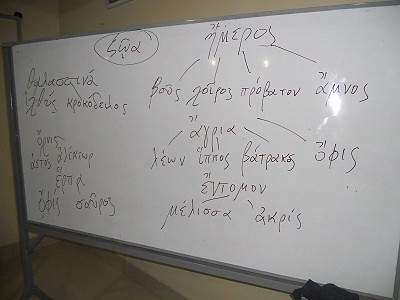
The actual paper preparation before putting those things up on the board was
Code: Select all
ζῷα
(τετράποδα)
ὁ χοῖρος
ὁ / ἡ βοῦς
ὁ ἵππος
θαλασσινά
ὁ ἰχθύς
ἕρπα
ὁ ὄφις
ἔντομα
ἄνθρωποι
ὁ στρατιώτης
ὁ ἀνήρ
ἡ γύνη
βρώματα
τὸ κρέας
ὁ ἄρτος
ἔπιπλα
ἡ τράπεζα
ἡ κάθεδρα
I also had figurines / models to help with learning those.
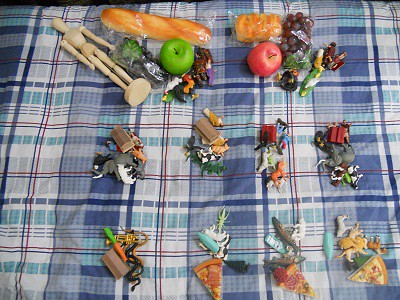
The 13cm artist's wooden doll helped to demonstrate some verbs too. (Sorry about the messy desk).

Besides actions in person, I also drew a few things up on the board.
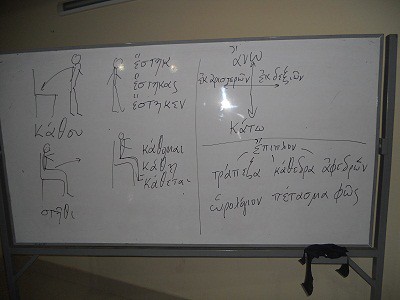
While the actual board-work was was dynamic and followed the flow of what we were talking about...
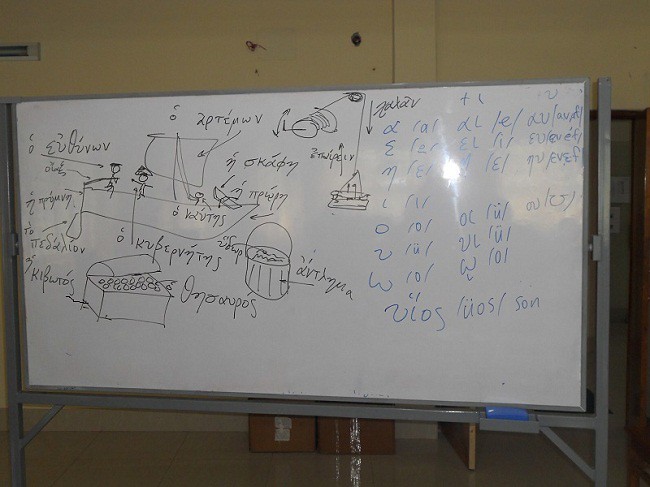
The work-sheets (which from my point of view represented the preparation for the lesson, and that from the students' point of view followed the, were a little neater, and targeted just required learning and expected retention of the material.

Learning was reinforced by the use (understand by playing with) of a 35cm tall - USD$8 model, which some of the students made up from a kit I had brought along, in their free time.

Similarly, for depth-sounding:
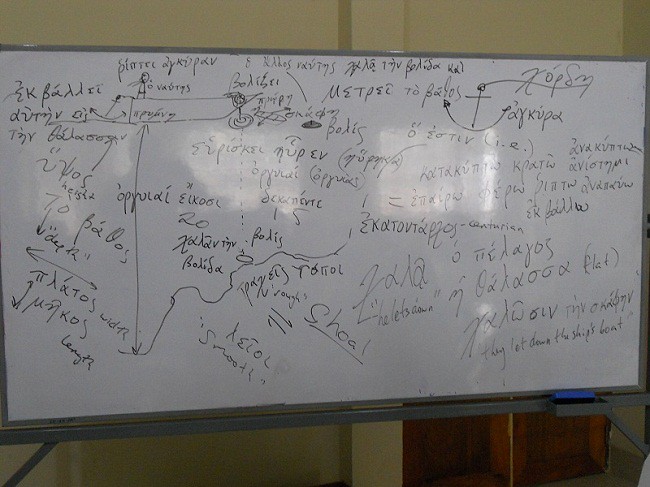
Worksheet, with the admonition to describe the picture
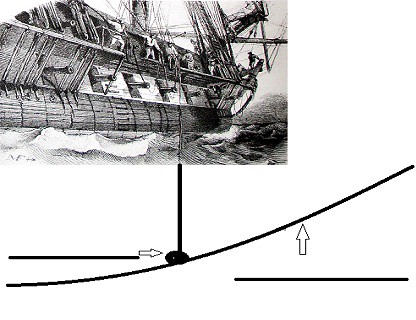
Of course there were many other themes and topics covered interactively. I didn't get pictures of people lying / sitting on the floor in various postures, because we were all involved to some extent or another. I know the students were filming me at sometimes from their grins that emerged from behind their smart phones, but didn't get copies of that.
On the non-interactive side, I also taught some classes of "grammar" reciting tables, which brought complaints, poor attendance, etc. and a series of "Greek for exegetical purposes" based on a scripture passage - that was well received.
Copies of the audio that the students were expected to learn / recite for their weekly and final testing, which Louis kindly uploaded for me is at: Audiofiles (mp3). There is nothing striking about them, but at least having them, that students had another resource and another way to learn. Based on the English glosses as explained (in English) in a non-interactive (more traditional lesson), some of the students translated the basic words of the New Testament occuring 100 times or more into their own first languages. But for testing they had to translate into English. It seemed that it was not difficult for them to achieve greater than 70% retention (50 or more words out of 70 in 2 days).
Some of this was based on my own efforts to learn the vocabulary of Acts 27, after Ed Krentz's comment that the vocabulary there was not obscure, and I realised they were just unknown to me.
I also prepared a longer word-list for a large part of Luke's Gospel, with pictures for more than 20% of the words(or cognate groups if there was no point in adding extra pictures when only the part of speech had changed, not the lexical meaning). I haven't rechecked it for copyright yet, so I won't post it now.
So much for my self-reflection...
[If you are going ahead with speaking and interaction, and you want to use figurines and have no means to source them, PM me and we might be able to arrange something.]